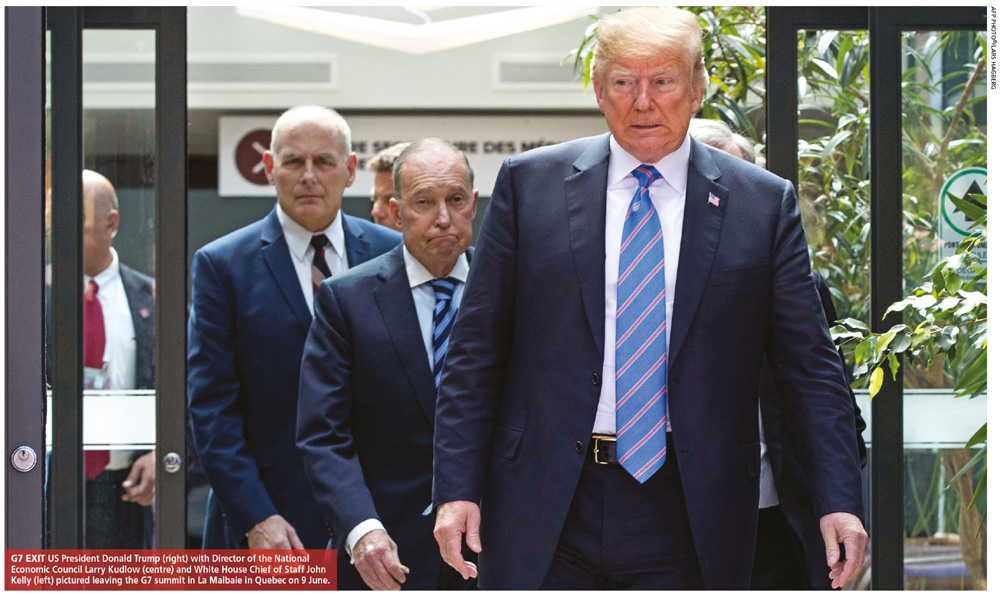US FOREIGN POLICY
TRUMP’S WORLD
Saro Thiruppathy critiques the shift in US foreign policy under the Trump administration
President Donald Trump makes the news just about every day; but on certain days, he hogs the limelight with his petulance and obstreperousness. His recent tantrums at the G7 meeting on 8-9 June in Quebec were over what he perceives as unfair retaliatory tariffs set by Canada and the EU on American goods, in response to the US tariff hikes on steel and aluminium.
Trump exacerbated the antagonism by arriving late in Canada, leaving early and insulting his host. The US president’s demand that Russia, which was banished following its annexation of Crimea, be included once more in the ‘family’ was met with a definite ‘nay.’
 And his offensive remarks about Canadian Prime Minister Justin Trudeau certainly did not please the six well-bred and well-mannered heads of state at the table.
And his offensive remarks about Canadian Prime Minister Justin Trudeau certainly did not please the six well-bred and well-mannered heads of state at the table.
G6 IS OKAY It seems that the G7 members are getting tired of Trump’s theatrics. French President Emmanuel Macron expressed this sentiment when he said that “maybe the American president doesn’t care about being isolated today but we don’t mind being six if needs be… Because these six represent values, an economic market and more than anything, a real force at the international level today.”
NO FRIENDS Trump generally attends global meetings in a fury over some injustice or the other that he perceives is being inflicted on the United States. His aggression during summits with US allies began with his beef with NATO last year when Trump accused member states of not footing their share of the bill. He said that some members owed “massive amounts of money” despite contributions from allies being voluntary and allocated from various budgets.
In one instance, the incumbent POTUS threatened to abandon European allies if their defence spending was insufficient. This unnerved the Baltic States, which fear that Moscow may attempt to annex them too.
Before long, he began raising dust by pulling out of the Trans-Pacific Partnership (TPP) and Paris Agreement on climate change. Trump even tried to pull out of NAFTA, shifted the US embassy in Israel to Jerusalem, and pulled out of the Iran nuclear deal and the UN Human Rights Council (UNHRC).
GO IT ALONE Hot on the heels of the traumatic G7 summit, he engaged in a historic meeting with North Korean leader Kim Jong-un in Singapore. Trump did not include anxious stakeholders like Japan and South Korea in the summit; and he went a step further and unilaterally assured Kim that US-South Korean ‘war games’ would cease, which caused consternation in Seoul.
Not only is Trump dismissive of US allies but also determined to have his own way irrespective of the consequences.
His foreign policy is crafted by him, his diplomatic outreach is determined by him, and global decisions that would require the consensus of at least immediate stakeholders are taken by him and him alone. Trump can’t be cajoled, charmed or bullied. But more dangerously, he is unwilling to listen to logic or reason.
THREE PILLARS So what does all this mean for regular US foreign policy? Post World War II, American foreign policy focussed on three fundamental pillars – viz. military superiority, diplomacy and economics. Maintaining military strength was of particular importance during the Cold War to counter communism and defend democracy. It also served as a deterrent against nuclear conflict and led the ‘war on terror.’
Besides the usual establishment of embassies and missions overseas, the US focussed on multilateral treaties and alliances, and developed rules for international trade and dispute resolution. It used its soft power to create an environment that was hospitable to American interests.
As the world’s largest economy and only superpower, America was able to flex its muscles around the globe. Even though it may not have had a positive trade balance with every nation, with its military strength, diplomatic policies and mega economy, Uncle Sam enjoyed the world’s attention.
AMERICA FIRST It is the combination of these three pillars that created the ‘America First’ doctrine. US foreign policy is meant to be long-term and statist; it crafted alliances with specific countries rather than regimes or leaders. US interests were protected through bilateral and multilateral agreements, and cooperation with other states made for a broader strategy for world supremacy.
While US presidents have left their mark on foreign policy vis-à-vis the climate, peace and war, none have rejected the fundamental pillars.
Trump’s regime seems to be centred on ad hoc and impulsive decisions; and his vision appears to be short term, driven by personal interests and bilateral in nature.
More drastically, Trump seems to have dismissed the good offices of diplomacy and soft power while placing great emphasis on military superiority and nationalistic economics. His relationships with the world are not statist and viewed on a country by country basis. In other words, President Donald J. Trump has turned US foreign policy on its head.
ASIAN SMILES Meanwhile, even as the G7 meeting (the group represents more than 62 percent of the world’s net worth, 46 percent of global GDP and 32 percent of the planet’s purchasing power) was in disarray, China was hosting the annual Shanghai Cooperation Organisation (SCO) meeting in Qingdao.
In stark contrast to the Canadian fiasco and despite disagreements between the SCO’s eight members, the Asian summit appears to have moved along harmoniously.






Trump’s foreign policy is a disaster for his country.